Plot summary
After departing the station at a ski facility, a passenger train begins descending a long downhill grade, only to discover that the brakes don't work, apparently frozen while at the mountain station. The train continues to gain speed, and one brakeman is lost trying to kick the frozen moisture off one section of brakes. It is anticipated that the train will derail at a sharp curve once it reaches level ground, and emergency crews stand by there. The train survives the curve and continues on toward the terminal station, where the tracks abruptly end.
A last desperate measure is tried: a locomotive will join the line after the runaway train passes, chase and latch onto the end of the train, then pull the train to a stop. Meanwhile, a young woman has decided to jump from the speeding train, and a young man tries to talk her out of it.
The chase locomotive nearly catches up as it is noticed by the conductor, but the train passes the "point of no return" at which point it should be impossible to stop the train, and the dispatcher orders it to back off. Travis, the rescuing engineer, slows, but won't sit still for abandoning the runaway. Travis pushes his engine beyond safe limits, comes very close to latching but missing, then latches on and applies the brakes. Symbolically, at the same moment as Travis hard latches, the young woman about to jump takes the hand of the young man.
With full brake power by the chase engine, the train comes to a halt some 65 feet (20 metres) from the block at the end of the track, and the family members of the passengers rush out of the station to greet their once-imperiled relatives.

The Denver and Rio Grande Western Railroad, often shortened to Rio Grande, D&RG or D&RGW, formerly the Denver & Rio Grande Railroad, was an American Class I railroad company. The railroad started as a 3 ft narrow-gauge line running south from Denver, Colorado, in 1870. It served mainly as a transcontinental bridge line between Denver and Salt Lake City, Utah. The Rio Grande was also a major origin of coal and mineral traffic.
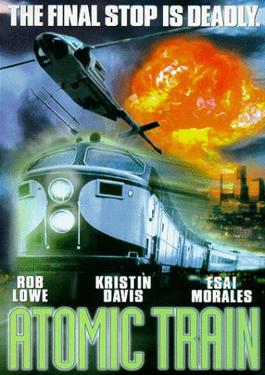
Atomic Train is a 1999 American made-for-television disaster-action-thriller miniseries about an accidental nuclear explosion destroying the city of Denver. It was originally broadcast on NBC in two parts on May 16 and 17, 1999.

The Cumbres and Toltec Scenic Railroad, often abbreviated as the C&TSRR, is a 3 ft narrow-gauge heritage railroad that operates on 64 miles (103 km) of track between Antonito, Colorado, and Chama, New Mexico, in the United States. The railroad is named for two geographical features along the route: the 10,015-foot (3,053 m)-high Cumbres Pass and the Toltec Gorge. Originally part of the Denver and Rio Grande Western Railroad's narrow-gauge network, the line has been jointly owned by the states of Colorado and New Mexico since 1970. Today, the C&TSRR is one of only two remaining parts of the former D&RGW narrow-gauge network, the other being the Durango and Silverton Narrow Gauge Railroad (D&SNG), which runs between the communities of Durango and Silverton, Colorado. The railroad has a total of ten narrow-gauge steam locomotives and two narrow-gauge diesel locomotives on its current roster. The railroad also operates two smaller former D&RGW steam locomotives, Nos. 315 and 168, for special events and excursions.

The Durango and Silverton Narrow Gauge Railroad, often abbreviated as the D&SNG, is a 3 ft (914 mm) narrow-gauge heritage railroad that operates on 45.2 mi (72.7 km) of track between Durango and Silverton, in the U.S. state of Colorado. The railway is a federally-designated National Historic Landmark and was also designated by the American Society of Civil Engineers as a National Historic Civil Engineering Landmark in 1968.

The Heber Valley Railroad (HVRX) is a heritage railroad based in Heber City, Utah. It operates passenger excursion trains along a line between Heber City and Vivian Park, which is located in Provo Canyon. The HVRX carries over 110,000 passengers a year.
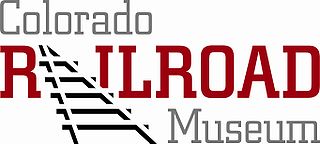
The Colorado Railroad Museum is a non-profit railroad museum. The museum is located on 15 acres (6.1 ha) at a point where Clear Creek flows between North and South Table Mountains in Golden, Colorado.

The Ghost Town & Calico Railway is a 3 ft narrow-gauge heritage railroad and amusement park attraction within Knott's Berry Farm, an amusement park located in Buena Park, California.

The Rio Grande Zephyr was a passenger train operated by Denver and Rio Grande Western Railroad between Denver, Colorado and Ogden, Utah from 1970 until 1983. In operation after the creation of publicly-funded Amtrak, the Rio Grande Zephyr was the last privately-operated interstate passenger train in the United States.

The D&RG Narrow Gauge Trestle, also known as the Cimarron Canyon trestle, is a narrow-gauge railroad deck truss bridge crossing the Cimarron River near Cimarron, Colorado. Located within the Curecanti National Recreation Area, the trestle is the last remaining railroad bridge along the Denver & Rio Grande Railroad's Black Canyon route, a narrow-gauge passenger and freight line that traversed the famous Black Canyon of the Gunnison between 1882 and the 1940s.

The Denver and Rio Grande Western K-27 is a class of 3 ft narrow gauge 2-8-2 "Mikado" type steam locomotives built for the Denver and Rio Grande Railroad by the Baldwin Locomotive Works in 1903. Known by their nickname "Mudhens," they were the first and the most numerous of the four K classes of Rio Grande narrow gauge engines to be built. Of the original fleet of 15 locomotives, two survive to this day and operate on heritage railways in the United States. No. 463 is operational on the Cumbres and Toltec Scenic Railroad (C&TSRR) in Chama, New Mexico and No. 464 is currently out of service due to a rebuild on the Huckleberry Railroad in Genesee Township, Michigan.

The Monarch Branch was a branch line of the Denver & Rio Grande Western built in the 1880s to serve the Colorado Fuel & Iron limestone quarry at Monarch, Colorado. Originally part of the D&RGW's 3 ft 0 in narrow-gauge system, the 15 mile line connected with the rest of the narrow-gauge network at Poncha Junction, on the Marshall Pass line. The upper part of the Branch was on a 4.5% grade and included both an "S" curve and a double switchback to reach an elevation of over 10,000 ft. The line was converted to standard-gauge in 1956 after the narrow-gauge mainline from Salida to Gunnison was closed in the early 1950s. From that time forward, the line operated as a standard-gauge branch of the D&RGW until the early 1980s when Colorado Fuel & Iron closed its blast furnaces at Pueblo, Colorado. Operations on the Monarch Branch subsequently ceased and the rails were pulled up a short time later.

The Denver and Rio Grande Western K-37 is a class of 2-8-2 "Mikado" type narrow-gauge steam locomotives built for the Denver and Rio Grande Western Railroad. They were new steam locomotives built in the D&RGW Burnham Shops as a near copy of the Rio Grande class K-36. In-house production was chosen to preemptively address material shortages and personnel issues. Burnham Shops was assisted in the construction of the class by the Stearn-Rogers Manufacturing Company. The class recycled components from Baldwin Locomotive Works-built Class 19 2-8-0 locomotives used on the Rio Grande's standard gauge; re-using the boiler, tender and other components salvaged from the C-41's. The engine components were constructed new for the locomotive class.
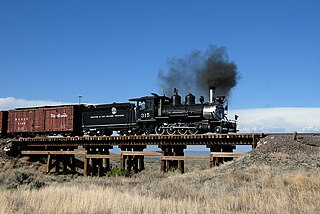
Denver and Rio Grande Western No. 315 is a class "C-18" 2-8-0 "Consolidation" type narrow-gauge steam locomotive that was originally built for the Florence and Cripple Creek Railroad by the Baldwin Locomotive Works in 1895. It was purchased by the Denver and Rio Grande Railroad (D&RG) in 1917 and later became known as No. 315. It was retired in 1949 and had been on display at City of Durango parks until the Durango Railroad Historical Society restored the locomotive from 2001 to August 2007. It was operational from then until September 2021. On March 8, 2023, it has returned to service, following its FRA federally mandated 1,472-day boiler inspection and overhaul. Most "sister" locomotives to No. 315 were scrapped, but two others survive today such as is D&RGW No. 318 and F&CC No. 10. No. 318 is on display at the Colorado Railroad Museum and F&CC No. 10 is currently in storage at the Nevada Southern Railroad Museum.

Denver and Rio Grande Western No. 169 is a 4-6-0 "Ten Wheeler" type narrow gauge steam railway locomotive. It is one of twelve similar locomotives built for the Denver and Rio Grande Railroad by Baldwin Locomotive Works in 1883. It was built as a passenger locomotive, with 46 in (1,200 mm) drivers, the second largest drivers used on any three foot gauge D&RGW locomotive.

Denver and Rio Grande Western No. 168 is a class "T-12" 4-6-0 “Ten Wheeler” type narrow-gauge steam railway locomotive. It is one of twelve similar locomotives built for the Denver and Rio Grande Railroad (D&RG) by the Baldwin Locomotive Works in 1883. It was built as a passenger locomotive, with 46 in (1,200 mm) drivers, the largest drivers used on any three foot gauge D&RGW locomotive. The large drivers made it suitable for relatively fast passenger service.
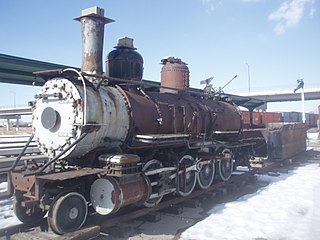
Denver and Rio Grande Western 223 is a 2-8-0 "Consolidation" type narrow-gauge steam railway locomotive built for the Denver and Rio Grande Railroad by the Grant Locomotive Works of Paterson, New Jersey in 1881-82. Number 223 was completed in December 1881, at a cost of $11,553. Baldwin built an additional 25 locomotives in the same class at the same time.

Cumbres and Toltec Scenic Railroad No. 463 is a 3-foot narrow-gauge class "K-27" 2-8-2 "Mikado" type steam railway locomotive built for the Denver and Rio Grande Railroad (D&RG) by the Baldwin Locomotive Works in 1903. It is one of two remaining locomotives of D&RGW class K-27, the other one being No. 464 at the Huckleberry Railroad in Genesee Township, Michigan. The class eventually became known by the nickname "Mudhens". Today, No. 463 is operational on the Cumbres and Toltec Scenic Railroad between Chama, New Mexico and Antonito, Colorado.
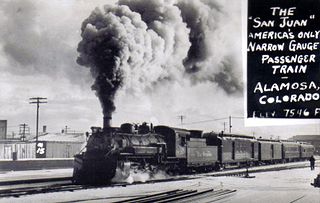
The San Juan Express was a narrow gauge train that ran on the 3 feet (0.91 m) Denver & Rio Grande Western Railroad (D&RGW) route from Durango, Colorado via Chama, New Mexico; Cumbres Pass; and Antonito, Colorado to Alamosa, Colorado. The train ran from February 11, 1937 until January 31, 1951 as train numbers 115 and 116, though towards the end of the passenger service it took on the number 215 and 216.

The Alamosa–Durango line or San Juan extension was a railroad line built by the Denver and Rio Grande Western Railroad, following the border between the U.S. states of Colorado and New Mexico, in the Rocky Mountains. The line was originally built as a 3 ft narrow-gauge line between Alamosa, Colorado, and Durango, Colorado. Portions of the route survive to this day: the now standard-gauged segment from Alamosa to Antonito, Colorado, and a narrow-gauge portion from Antonito to Chama, New Mexico.
The Exposition Flyer was a passenger train jointly operated by the Chicago, Burlington & Quincy (CB&Q), Denver & Rio Grande Western (D&RGW), and Western Pacific (WP) railroads between Chicago and Oakland, California, for a decade between 1939 and 1949, before being replaced by the famed California Zephyr.


















